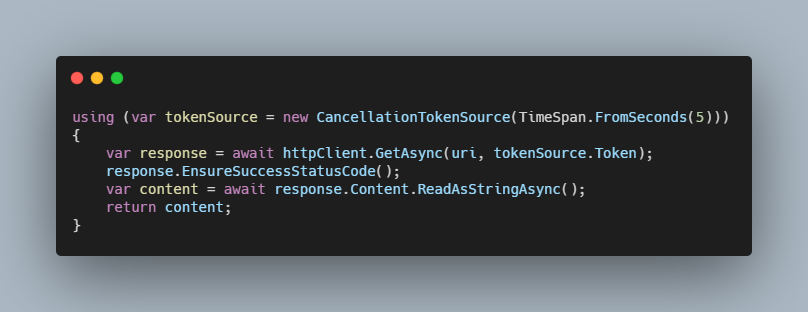
onStatus(HttpStatus::is4xxClientError, resp -> ", resp. Moreover, we can also add some logic according to the HTTP status: webClient.get() We can reuse any previously described exceptions and write our own handling methods using Reactor.

doOnError(WriteTimeoutException.class, ex -> log.error("WriteTimeout")) Once the problem is resolved, you can turn on the plugins one by one to find out which was responsible for the HTTP error message. onErrorReturn(SslHandshakeTimeoutException.class, new TextNode("SslHandshakeTimeout")) To test whether the timeout error is due to one or more included extensions, temporarily deactivate them completely. onErrorMap(ReadTimeoutException.class, ex -> new HttpTimeoutException("ReadTimeout"))

Each type of timeout delivers a dedicated exception, so we can easily handle them using Ractive Streams and onError blocks : webClient.get() Now it's time to quickly talk about exception handling. We've just learned about different timeout configurations. The underlying Netty library delivers ReadTimeoutException and WriteTimeoutException classes accordingly to handle errors. For the first one, we provided a number with the TimeUnit specification, while the second converts the given number to seconds. The constructors for these handlers accept two variants of parameters. To configure timeouts we added ReadTimeOutHandlerand WriteTimeOutHandler instances. In this situation, we configured a connected callback via the doOnConnected() method, where we created additional handlers. addHandler(new WriteTimeoutHandler(10))) addHandler(new ReadTimeoutHandler(10, TimeUnit.SECONDS)) The HttpClient allows to configure additional handlers to configure those timeouts: HttpClient client = HttpClient.create() When the connection is not established in a given time or dropped, a ConnectTimeoutException is thrown.Ī read timeout occurs when no data was read within a certain period of time, while the write timeout when a write operation cannot finish at a specific time. We also set the maximum number of probes before the connection dropping to 8. Without timeouts, requests that get stuck or take a long time to complete. So, we've enabled keep-alive checks to probe after 5 minutes of being idle, at 60 seconds intervals. It is necessary to enforce timeouts on client connections on a production web server. option(EpollChannelOption.TCP_KEEPCNT, 8) option(EpollChannelOption.TCP_KEEPINTVL, 60) option(EpollChannelOption.TCP_KEEPIDLE, 300) option(ChannelOption.SO_KEEPALIVE, true)
#HTTP CLIENT TIMEOUT WINDOWS#
Moreover, we can configure the keep-alive option, which will send TCP check probes when the connection is idle: HttpClient client = HttpClient.create() Setting the HTTP Client timeout to -1 JFiddie Member 07-15-2021 04:12 PM Options LabVIEW The documentation states 'A value of -1 defers timeout monitoring to the operating system.' I am trying to figure out what that means in regard to Windows operating systems and I have not been able to dig up anything. Netty sets that value to 30 seconds by default. The value provided is in milliseconds, so we configured the timeout for 10 seconds. option(ChannelOption.CONNECT_TIMEOUT_MILLIS, 10000) We can use different channel options keys and the option() method to perform the configuration: HttpClient client = HttpClient.create() Public static void put(HttpUriRequest request), requestTimeout, TimeUnit.The connection timeout is a period within which a connection between a client and a server must be established. Private static final ScheduledExecutorService exe = Executors.newScheduledThreadPool(1) Įxe.schedule(RequestCache::cleanup, 1, TimeUnit.MINUTES) Private static final Map cache = new ConcurrentHashMap()

A logon screen is displayed in the browser 3. 400 Session timed out - please log in again) 2. An error message is displayed in the browser (e.g. Private static final long expireInMillis = 300000 When the user interacts with the browser after the session has been deleted, the possible system responses are: 1. Your cache along with watchdog thread may look like this. abort requests which are not complete within your limit.remove request from cache when complete.

The solution I propose require only 1 watchdog thread and will save you resources time and nerves. Imagine 1000 req/min means 1000 threads or workers / min. The underlying windows handler WinHttpHandler has the ti.
#HTTP CLIENT TIMEOUT CODE#
Otherwise you will quickly run into all kind of memory issues with more or less real environment. The HttpClient from the package has Timeout property that defaults to a 100 seconds which as I read through the code just means how long till the task is cancelled. Using timer or executor or any other mechanism which creates a thread/runnable object per request is a very bad idea.


 0 kommentar(er)
0 kommentar(er)
